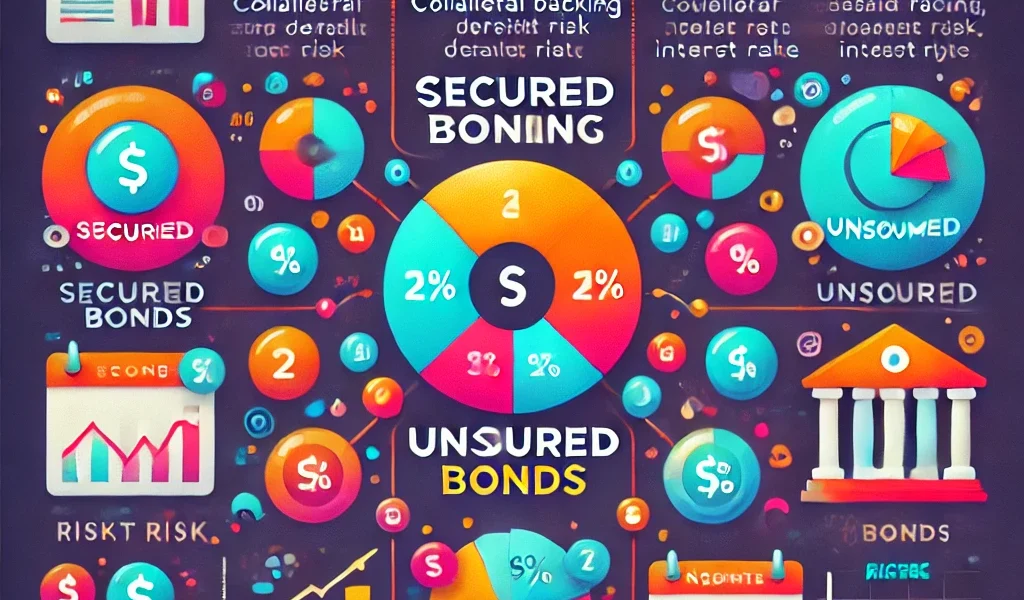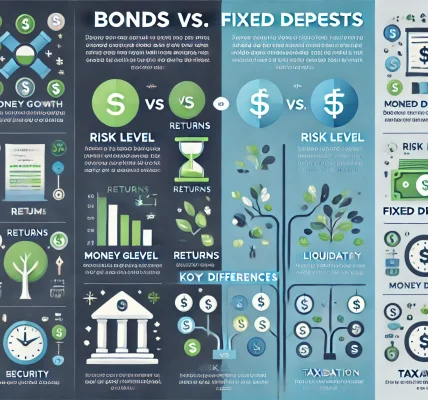Introduction
Bonds are a popular investment choice for individuals looking to earn stable returns while preserving capital. However, understanding the difference between secured and unsecured bonds is critical for making smart investment decisions. Each type of bond carries its own set of risks and rewards, making it essential for investors to choose the right option based on their financial goals and risk appetite.
In this comprehensive guide, we will explore the key differences between secured and unsecured bonds, analyze their risk profiles, examine their returns, and provide actionable tips for building a balanced bond portfolio.
🎯 What Are Secured Bonds?
Secured bonds are debt instruments backed by collateral or specific assets of the issuing entity. If the issuer defaults on payments, bondholders have a legal claim over the pledged assets, ensuring greater protection.
✅ Key Features of Secured Bonds:
- Collateral-Backed Security: Assets such as real estate, equipment, or revenue streams secure the bond.
- Lower Risk Profile: Reduced risk due to asset backing.
- Priority in Liquidation: Bondholders receive repayment before unsecured creditors in case of bankruptcy.
Examples of Secured Bonds:
- Mortgage-Backed Bonds: Backed by real estate mortgages.
- Equipment Trust Certificates: Backed by physical assets like aircraft, machinery, or transportation equipment.
📊 How Do Secured Bonds Work?
When an investor buys a secured bond:
- The bond issuer pledges specific assets as collateral.
- If the issuer defaults, bondholders can seize and sell the collateral to recover the principal amount.
- Secured bondholders are prioritized in repayment during bankruptcy or liquidation.
✅ Pro Tip: Secured bonds are ideal for risk-averse investors who prioritize capital protection over higher yields.
📈 Advantages of Secured Bonds
1. 🛡️ Lower Default Risk
Secured bonds provide protection through pledged assets, reducing the likelihood of total loss.
2. 💸 Higher Recovery Rate in Bankruptcy
In the event of a default, secured bondholders are repaid before unsecured creditors.
3. 📚 Stable and Predictable Returns
Secured bonds offer consistent income with reduced price volatility.
⚠️ Disadvantages of Secured Bonds
1. 📉 Lower Yields Compared to Unsecured Bonds
Due to lower risk, secured bonds offer lower yields, making them less attractive to high-risk investors.
2. 🏢 Limited Upside Potential
Secured bonds provide stable but limited upside potential compared to riskier assets.
🎯 What Are Unsecured Bonds?
Unsecured bonds (also known as debentures) are debt instruments that are not backed by any collateral. Instead, they are supported solely by the issuer’s creditworthiness and reputation.
✅ Key Features of Unsecured Bonds:
- No Collateral Requirement: Issued based on the issuer’s credit profile.
- Higher Risk Profile: Greater risk due to lack of asset backing.
- Higher Yields: To compensate for the increased risk, unsecured bonds typically offer higher interest rates.
Examples of Unsecured Bonds:
- Corporate Debentures: Issued by corporations without asset backing.
- Subordinated Bonds: Lower priority bonds in terms of repayment.
📊 How Do Unsecured Bonds Work?
When an investor buys an unsecured bond:
- The issuer promises to repay the principal and interest based solely on its financial stability.
- Bondholders rely on the issuer’s ability to generate future cash flows.
- In case of default, unsecured bondholders are repaid after secured creditors and other senior debt holders.
✅ Pro Tip: Unsecured bonds are ideal for investors seeking higher returns but willing to accept increased risk.
📈 Advantages of Unsecured Bonds
1. 📈 Higher Yields and Returns
Unsecured bonds offer higher interest payments to compensate for the additional risk.
2. 💡 Flexibility for Issuers
Issuers can raise capital without pledging specific assets, allowing for greater financial flexibility.
3. 📚 Diversification Opportunity
Including unsecured bonds in a portfolio adds diversification and enhances overall returns.
⚠️ Disadvantages of Unsecured Bonds
1. 📉 Higher Default Risk
Unsecured bonds carry a higher risk of default, especially during economic downturns.
2. ⏳ Lower Recovery Rate in Bankruptcy
In the event of a default, unsecured bondholders may receive little to no repayment.
🔥 Secured vs. Unsecured Bonds: Key Differences
| Feature | Secured Bonds | Unsecured Bonds |
|---|---|---|
| Collateral | Backed by assets | No collateral |
| Default Risk | Lower due to asset backing | Higher due to credit risk |
| Interest Rate | Lower due to reduced risk | Higher to compensate for risk |
| Priority in Liquidation | Higher (paid before others) | Lower (paid after secured bonds) |
| Return Potential | Stable but limited | Higher potential returns |
| Investor Suitability | Conservative investors | Aggressive, high-risk investors |
📈 Which Bond is Better for Different Investment Objectives?
✅ Secured Bonds:
- Best suited for conservative investors seeking stable income and low default risk.
- Ideal for those prioritizing capital preservation over high returns.
✅ Unsecured Bonds:
- Suitable for aggressive investors willing to take on higher risk for potentially higher returns.
- Ideal for investors seeking diversification and capital appreciation.
🎯 How to Choose Between Secured and Unsecured Bonds
When selecting between secured and unsecured bonds, consider the following factors:
1. 📝 Risk Tolerance
- Conservative investors should prioritize secured bonds for stability.
- Aggressive investors can explore unsecured bonds for higher returns.
2. 💸 Return Expectations
- If you’re seeking consistent, predictable income, secured bonds are the safer option.
- For higher yield potential, unsecured bonds offer better opportunities.
3. 🔍 Issuer Creditworthiness
- Evaluate the issuer’s financial strength and credit rating before investing in unsecured bonds.
4. 📈 Market Conditions
- Secured bonds perform better in uncertain or volatile markets.
- Unsecured bonds thrive during periods of economic growth and stability.
⚖️ Tax Implications of Secured and Unsecured Bonds
1. 💡 Tax Treatment of Interest Income
- Interest income from both secured and unsecured bonds is taxed as ordinary income.
- Municipal bonds may offer tax-free income, depending on the issuer and jurisdiction.
2. 📉 Capital Gains or Losses
- Selling bonds before maturity may result in capital gains or losses, which are taxed accordingly.
✅ Pro Tip: Investors in high tax brackets may benefit from municipal bonds for tax efficiency.
📚 Case Study: Choosing Between Secured and Unsecured Bonds
Scenario:
- Investor A is a conservative retiree seeking consistent income and capital preservation.
- Investor B is an aggressive young investor aiming for high returns and diversification.
✅ Investor A’s Choice: Secured bonds with asset backing to ensure stable income.
✅ Investor B’s Choice: Unsecured bonds to maximize returns while accepting higher risk.
🎉 Conclusion: Make Smart Investment Choices with Secured and Unsecured Bonds
Choosing between secured and unsecured bonds depends on an investor’s risk tolerance, income needs, and long-term financial goals. Secured bonds offer stability and lower default risk, making them ideal for conservative investors, while unsecured bonds provide higher yields for those willing to embrace additional risk.
By understanding the nuances of each bond type and aligning them with your investment strategy, you can build a diversified and resilient bond portfolio that thrives in any market condition.




